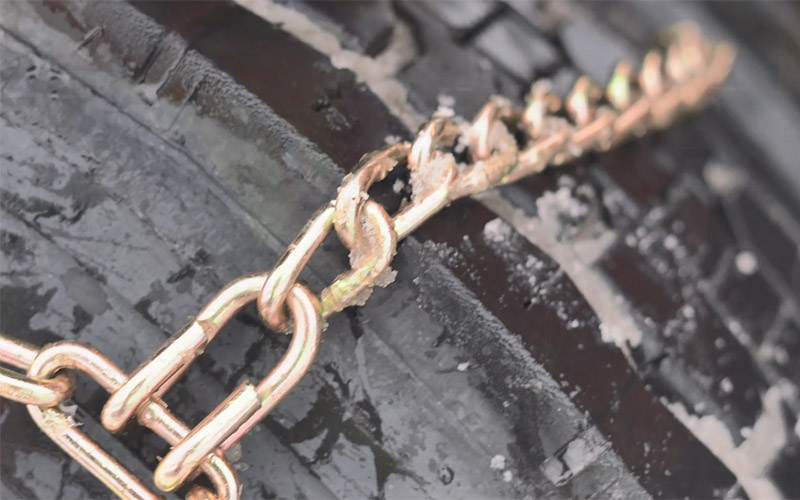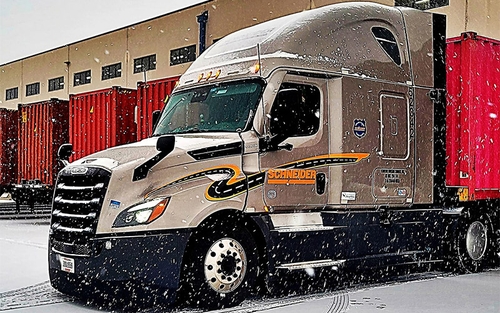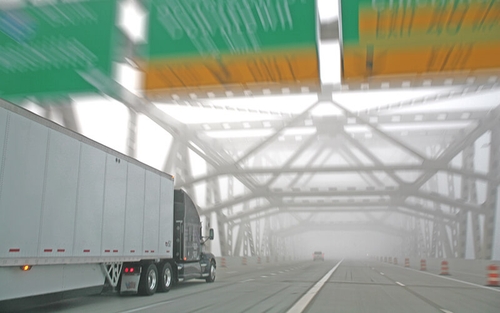How to put tire chains on a semi: 8 steps to follow


By The Schneider Guy
Estimated reading time: 3 minutes
In the winter, snow and slippery roads can make mountain driving challenging for truck drivers, and tire chains may be necessary to ensure your safety.
Keep reading to see our step-by-step guide on how to put tire chains on a semi-truck.
Tutorial video on chaining up a semi-truck
How to put tire chains on a semi-truck
1. Take the chains out of the bag.
After parking in a safe and legal location, such as a rest area, truck stop or company facility, take your chains out of their storage bag. Chains often hook onto one another, so some untangling may be necessary.
2. Lay out the chains.
When laying out the chains, make sure the hooks face up. This will ensure they face out when you place them on the tires. All the tensioners should be open.
3. Clean off the hooks.
If you lay out your chains on a snow-covered surface, brush snow off the chains before putting them on your tires. Gloves should be worn throughout this entire process.
4. Drape the chains over the tire.
Drape the chains over the tire, with at least half of the chain falling to each side. Use your fingers to clean any remaining snow off the chains. Make sure the hooks are facing out and the tensioners are open.
5. Connect the chains.
It is necessary to get under the truck to connect the chains. The inside chain is typically the hardest one to connect, so be patient.
6. Check the number of links.
Make sure you have the same number of links on the inside of the tire as you do on the outside of the tire. For example, if you connect the third link on the inside chain, make sure the outside chain is also connected to the third outside link.
Start over if you have an imbalance, as the chains will not properly rotate around the tire if you do.
7. Tighten the chains.
Use a tensioning tool to tighten the chains. Leave one finger’s worth of space between the chains and the tire. Do not overtighten them, as they must be able to rotate slowly around the tire.
8. Move your truck forward.
Move the truck forward at least 100 feet to set the chains, then recheck the tightness.
Frequently asked questions about chaining up a semi-truck
How many tires need to be chained on a semi-truck?
While the number of tires that need to be chained varies based on weather conditions and state laws, in general, truck drivers must chain the tires of at least one drive axle.
When trip planning, make sure to look up the regulations of the state(s) you will be driving in. California, for example, requires chains on all four tires of the first drive axle, the outside wheels of the second drive axle and the outside of the rear trailer axle.
How fast can you drive with chains on a semi-truck?
When using tire chains, it is best to take it slow. Try not to exceed 30 mph when driving with chains on.
How do you keep tire chains in good condition?
To keep your tire chains in good condition for as long as possible:
- Make sure your chains slowly rotate around the tire.
- Do not exceed 30 mph when using chains.
- Avoid prolonged use of tire chains on bare pavement.
- Avoid spinning the tires or locking up the brakes when using chains.
- Retighten the chains periodically, allowing for at least one finger's worth of space between the chains and tires.
When do you need to put chains on a semi-truck?
Tire chains are allowed in all lower 48 states when driving conditions are poor.
Tire chains are required depending on the weather conditions and the state(s) you are driving in.
In mountainous states, such as Wyoming, Utah and Colorado, drivers are required to carry chains with them during certain times of the year. Drivers must use chains when requirements are put in effect due to weather conditions.
In most cases, drivers are encouraged to use their stop work authority when they do not feel comfortable driving in inclement weather.
Please note the list and video above are just examples. It is important to remember the type of driver you are, the company you work for and the type of truck you drive can impact how you put tire chains on a semi-truck. Be sure to consult your company guidelines or speak with your leader for more information about putting tire chains on a semi-truck.
Looking for more winter weather driving tips?

Schneider Guy loves the "Big Orange." He's passionate about the trucking industry and connecting people to rewarding careers within it. He's been the eyes and ears of our company since our founding in 1935, and he's excited to interact with prospective and current Schneider associates through "A Slice of Orange."



